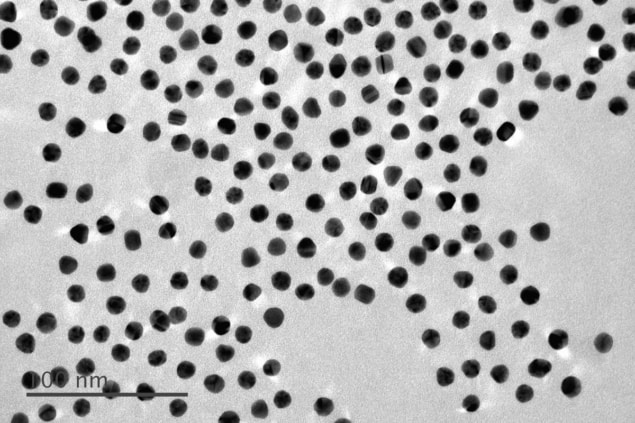
Researchers in the US have explored the impact of specific proteases expressed by cancer cells on biomolecules that form around gold nanoparticles targeted at pancreatic tumours. They found that the effect of proteases on the aggregated biomolecules is complex (ACS Appl. Mater. Interfaces 10.1021/acsami.9b00928).
Gold nanoparticles show promise as potent drug carriers for cancer treatment and diagnosis. However, the engineering of gold nanoparticles is just at its beginning. Notably, their interaction with biomolecules found in biological fluids during therapy is a major topic of investigation. These biomolecules, which occur in different compositions, spontaneously form a “cloud” around the gold nanoparticles, referred to as a “protein corona”.
Protein corona composition has become a major factor in customizing gold nanoparticles for drug delivery. But despite all the studies performed to date, the impact of protein corona composition on the interaction between gold nanoparticles and cancer cells that secrete matrix metalloproteinases (MMPs) remains relatively unexplored.
MMPs are a group of enzymes that degrade different proteins, especially collagen. MMPs help cancer cells proliferate and migrate faster throughout healthy tissue by degrading the extracellular matrix and therefore creating free space for cancer cells to spread. It is known that various compositions of the protein corona may affect this degradation process. But since MMPs are proteins themselves, their exchange with other proteins in the corona potentially gives rise to a complex net effect.
Protein selection
To investigate the impact of proteases, the researchers — led by Kimberly Hamad-Schifferli at the University of Massachusetts Boston — studied coronas composed of different model proteins. They used two main criteria to choose the different model proteins: the strength of their interaction with gold nanoparticles, and the proteases that pancreatic cancer cells secrete. The team used an established pancreatic adenocarcinoma cell line called PANC-1, which secretes two major MMPs: MMP-2 and MMP-9. In this work, they focused more on studying MMP-9.

In order to work with a well-studied system, the researchers chose human serum, as it offers both strongly- and weakly-bound corona proteins. They also used pure human serum albumin as a model that involved only weakly-bound corona proteins when inside a biological fluid.
To more specifically study MMP-9 activity, the researchers chose collagen IV as another corona protein, as it is the substrate of MMP-9. Then to search for the specific proteins that are degraded by the proteases that PANC-1 cells secrete, and to probe the protein corona composition, they introduced a protease inhibitor to the cell medium. Finally, they isolated corona proteins from the gold nanoparticles inside the cell medium and analysed these via mass spectrometry.
Protein corona degradation
Focusing on MMP-9, the team found that its activity influenced the final composition of the protein corona in cell medium, as well as its properties, such as the time scales for exchange, adsorption or degradation. In particular, the researchers found that size of the corona changes. However, the factors resulting in either an increase or decrease in the size of protein corona could not be analysed — the changes are not straightforward. Exposure to MMP-9 does not always lead to a decrease in the size of protein corona due to digestion; as MMP-9 itself is a protein, it can exchange with the gold nanoparticles in the fluid. As a consequence, this varies the size of the protein corona depending upon the MMP-9 on/off binding states.
“Together, these results indicate that the mechanism of protease activity on gold nanoparticles coronas involves both rearrangement and exchange, followed by degradation,” the authors concluded.



